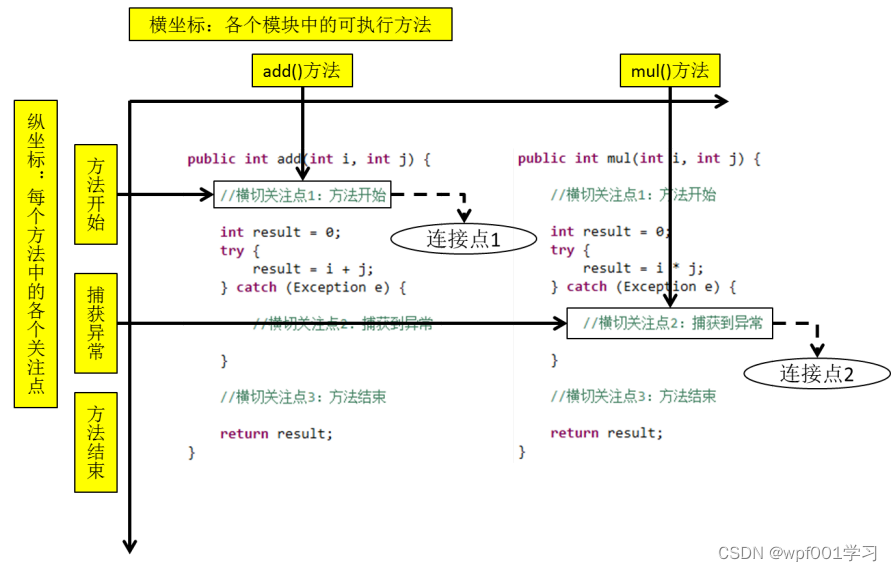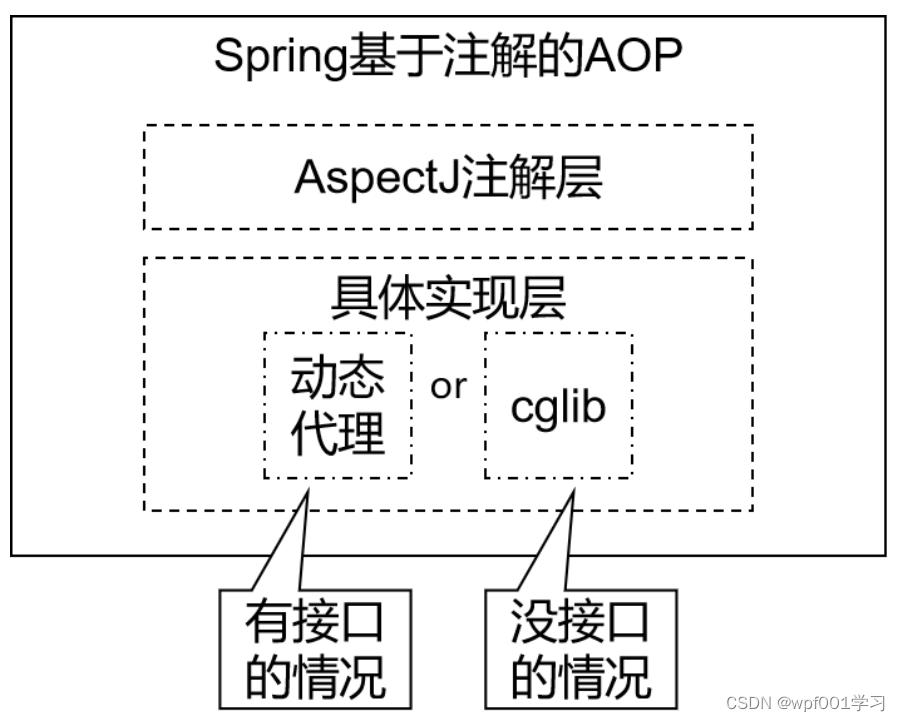目录
1、AOP概述及相关术语
1.1、概念
AOP(Aspect Oriented Programming)是一种设计思想,是软件设计领域中的面向切面编程,它是面 向对象编程的一种补充和完善,它以通过预编译方式和运行期动态代理方式实现在不修改源代码的情况 下给程序动态统一添加额外功能的一种技术。
1.2、相关术语
1.2.1、横切关注点
从每个方法中抽取出来的同一类非核心业务。在同一个项目中,我们可以使用多个横切关注点对相关方 法进行多个不同方面的增强。
这个概念不是语法层面天然存在的,而是根据附加功能的逻辑上的需要:有十个附加功能,就有十个横 切关注点。
1.2.2、通知
每一个横切关注点上要做的事情都需要写一个方法来实现,这样的方法就叫通知方法。
前置通知:在被代理的目标方法前执行
返回通知:在被代理的目标方法成功结束后执行(寿终正寝)
异常通知:在被代理的目标方法异常结束后执行(死于非命)
后置通知:在被代理的目标方法最终结束后执行(盖棺定论)
环绕通知:使用try...catch...finally结构围绕整个被代理的目标方法,包括上面四种通知对应的所有位置
1.2.3、切面
封装通知方法的类
1.2.4、目标
被代理的目标对象
1.2.5、代理
向目标对象应用通知之后创建的代理对象
1.2.6、连接点
这也是一个纯逻辑概念,不是语法定义的。
把方法排成一排,每一个横切位置看成x轴方向,把方法从上到下执行的顺序看成y轴,x轴和y轴的交叉点就是连接点。

1.2.7、切入点
定位连接点的方式。
每个类的方法中都包含多个连接点,所以连接点是类中客观存在的事物(从逻辑上来说)。
如果把连接点看作数据库中的记录,那么切入点就是查询记录的 SQL 语句。
Spring 的 AOP 技术可以通过切入点定位到特定的连接点。
切点通过org.springframework.aop.Pointcut 接口进行描述,它使用类和方法作为连接点的查询条 件。
1.3、作用
简化代码:把方法中固定位置的重复的代码抽取出来,让被抽取的方法更专注于自己的核心功能, 提高内聚性。
代码增强:把特定的功能封装到切面类中,看哪里有需要,就往上套,被套用了切面逻辑的方法就 被切面给增强了。
2、基于注解的AOP
2.1、技术说明

动态代理(InvocationHandler):JDK原生的实现方式,需要被代理的目标类必须实现接口。因 为这个技术要求代理对象和目标对象实现同样的接口(兄弟两个拜把子模式)。
cglib:通过继承被代理的目标类(认干爹模式)实现代理,所以不需要目标类实现接口。
AspectJ:本质上是静态代理,将代理逻辑“织入”被代理的目标类编译得到的字节码文件,所以最 终效果是动态的。weaver就是织入器。Spring只是借用了AspectJ中的注解。
2.2、准备工作
1、添加依赖
<dependencies>
<!-- 基于Maven依赖传递性,导入spring-context依赖即可导入当前所需所有jar包 -->
<dependency>
<groupId>org.springframework</groupId>
<artifactId>spring-context</artifactId>
<version>5.3.1</version>
</dependency>
<!-- junit测试 -->
<dependency>
<groupId>junit</groupId>
<artifactId>junit</artifactId>
<version>4.12</version>
<scope>test</scope>
</dependency>
<!-- spring-aspects会帮我们传递过来aspectjweaver -->
<dependency>
<groupId>org.springframework</groupId>
<artifactId>spring-aspects</artifactId>
<version>5.3.1</version>
</dependency>
</dependencies>2、准备被代理的目标资源
接口:
public interface Calculator {
int add(int i, int j);
int sub(int i, int j);
int mul(int i, int j);
int div(int i, int j);
}实现类:
@Component
public class CalculatorImpl implements Calculator {
@Override
public int add(int i, int j) {
int result = i + j;
System.out.println("方法内部,result:"+result);
return result;
}
@Override
public int sub(int i, int j) {
int result = i - j;
System.out.println("方法内部,result:"+result);
return result;
}
@Override
public int mul(int i, int j) {
int result = i * j;
System.out.println("方法内部,result:"+result);
return result;
}
@Override
public int div(int i, int j) {
int result = i / j;
System.out.println("方法内部,result:"+result);
return result;
}
}
2.3、创建切面类并配置
/**
* 1、在切面中,需要通过指定的注解将方法标识为通知方法
* @Before:前置通知,在目标对象方法执行之前执行
* @After:后置通知,在目标对象方法的finally字句中执行
* @AfterReturning:返回通知,在目标对象方法返回值之后执行
* @AfterThrowing:异常通知,在目标对象方法的catch字句中执行
*
*
* 2、切入点表达式:设置在标识通知的注解的value属性中
* execution(public int com.atguigu.spring.aop.annotation.CalculatorImpl.add(int, int)
* execution(* com.atguigu.spring.aop.annotation.CalculatorImpl.*(..)
* 第一个*表示任意的访问修饰符和返回值类型
* 第二个*表示类中任意的方法
* ..表示任意的参数列表
* 类的地方也可以使用*,表示包下所有的类
* 3、重用切入点表达式
* //@Pointcut声明一个公共的切入点表达式
* @Pointcut("execution(* com.atguigu.spring.aop.annotation.CalculatorImpl.*(..))")
* public void pointCut(){}
* 使用方式:@Before("pointCut()")
*
* 4、获取连接点的信息
* 在通知方法的参数位置,设置JoinPoint类型的参数,就可以获取连接点所对应方法的信息
* //获取连接点所对应方法的签名信息
* Signature signature = joinPoint.getSignature();
* //获取连接点所对应方法的参数
* Object[] args = joinPoint.getArgs();
*
* 5、切面的优先级
* 可以通过@Order注解的value属性设置优先级,默认值Integer的最大值
* @Order注解的value属性值越小,优先级越高
*
*/
@Component
@Aspect //将当前组件标识为切面
public class LoggerAspect {
@Pointcut("execution(* com.atguigu.spring.aop.annotation.CalculatorImpl.*(..))")
public void pointCut(){}
//@Before("execution(public int com.atguigu.spring.aop.annotation.CalculatorImpl.add(int, int))")
//@Before("execution(* com.atguigu.spring.aop.annotation.CalculatorImpl.*(..))")
@Before("pointCut()")
public void beforeAdviceMethod(JoinPoint joinPoint) {
//获取连接点所对应方法的签名信息
Signature signature = joinPoint.getSignature();
//获取连接点所对应方法的参数
Object[] args = joinPoint.getArgs();
System.out.println("LoggerAspect,方法:"+signature.getName()+",参数:"+ Arrays.toString(args));
}
@After("pointCut()")
public void afterAdviceMethod(JoinPoint joinPoint){
//获取连接点所对应方法的签名信息
Signature signature = joinPoint.getSignature();
System.out.println("LoggerAspect,方法:"+signature.getName()+",执行完毕");
}
/**
* 在返回通知中若要获取目标对象方法的返回值
* 只需要通过@AfterReturning注解的returning属性
* 就可以将通知方法的某个参数指定为接收目标对象方法的返回值的参数
*/
@AfterReturning(value = "pointCut()", returning = "result")
public void afterReturningAdviceMethod(JoinPoint joinPoint, Object result){
//获取连接点所对应方法的签名信息
Signature signature = joinPoint.getSignature();
System.out.println("LoggerAspect,方法:"+signature.getName()+",结果:"+result);
}
/**
* 在异常通知中若要获取目标对象方法的异常
* 只需要通过AfterThrowing注解的throwing属性
* 就可以将通知方法的某个参数指定为接收目标对象方法出现的异常的参数
*/
@AfterThrowing(value = "pointCut()", throwing = "ex")
public void afterThrowingAdviceMethod(JoinPoint joinPoint, Throwable ex){
//获取连接点所对应方法的签名信息
Signature signature = joinPoint.getSignature();
System.out.println("LoggerAspect,方法:"+signature.getName()+",异常:"+ex);
}
@Around("pointCut()")
//环绕通知的方法的返回值一定要和目标对象方法的返回值一致
public Object aroundAdviceMethod(ProceedingJoinPoint joinPoint){
Object result = null;
try {
System.out.println("环绕通知-->前置通知");
//表示目标对象方法的执行
result = joinPoint.proceed();
System.out.println("环绕通知-->返回通知");
} catch (Throwable throwable) {
throwable.printStackTrace();
System.out.println("环绕通知-->异常通知");
} finally {
System.out.println("环绕通知-->后置通知");
}
return result;
}
}
在spring的配置文件中配置
<!--
AOP的注意事项:
切面类和目标类都需要交给IOC容器管理
切面类必须通过@Aspect注解标识为一个切面
在Spring的配置文件中设置<aop:aspectj-autoproxy />开启基于注解的AOP
-->
<context:component-scan base-package="com.itwpf.spring.aop.annotation"></context:component-scan>
<!--开启基于注解的AOP-->
<aop:aspectj-autoproxy />2.4、各种通知
前置通知:使用@Before注解标识,在被代理的目标方法前执行
返回通知:使用@AfterReturning注解标识,在被代理的目标方法成功结束后执行(寿终正寝)
异常通知:使用@AfterThrowing注解标识,在被代理的目标方法异常结束后执行(死于非命)
后置通知:使用@After注解标识,在被代理的目标方法最终结束后执行(盖棺定论)
环绕通知:使用@Around注解标识,使用try...catch...finally结构围绕整个被代理的目标方法,包 括上面四种通知对应的所有位置
各种通知执行的顺序:
Spring版本5.3.x以前:
前置通知
目标操作
后置通知
返回通知或异常通知
Spring版本5.3.x以后:
前置通知
目标操作
返回通知或异常通知
后置通知
2.5、切入点表达式语法
2.5.1、作用

2.5.2、语法细节
用*号代替 “权限修饰符” 和 “返回值” 部分表示 “权限修饰符” 和 “返回值”不限
在包名的部分,一个“*”号只能代表包的层次结构中的一层,表示这一层是任意的。
例如:*.Hello匹配com.Hello,不匹配com.itwpf.Hello
在包名的部分,使用“*..”表示包名任意、包的层次深度任意在类名的部分,类名部分整体用*号代替,表示类名任意 在类名的部分,可以使用*号代替类名的一部分
例如:*Service匹配所有名称以Service结尾的类或接口
在方法名部分,可以使用*号表示方法名任意 在方法名部分,可以使用*号代替方法名的一部分
例如:*Operation匹配所有方法名以Operation结尾的方法
在方法参数列表部分,使用(..)表示参数列表任意 在方法参数列表部分,使用(int,..)表示参数列表以一个int类型的参数开头
在方法参数列表部分,基本数据类型和对应的包装类型是不一样的切入点表达式中使用 int 和实际方法中 Integer 是不匹配的
在方法返回值部分,如果想要明确指定一个返回值类型,那么必须同时写明权限修饰符
例如:execution(public int ..Service.*(.., int)) 正确 例如:execution(* int ..Service.*(.., int)) 错误

2.6、重用切入点表达式
声明:
@Pointcut("execution(* com.itwpf.aop.annotation.*.*(..))")
public void pointCut(){}在同一个切面使用:
@Before("pointCut()")
public void beforeMethod(JoinPoint joinPoint){
String methodName = joinPoint.getSignature().getName();
String args = Arrays.toString(joinPoint.getArgs());
System.out.println("Logger-->前置通知,方法名:"+methodName+",参数:"+args);
}
在不同切面使用:
@Before("com.atguigu.aop.CommonPointCut.pointCut()")
public void beforeMethod(JoinPoint joinPoint){
String methodName = joinPoint.getSignature().getName();
String args = Arrays.toString(joinPoint.getArgs());
System.out.println("Logger-->前置通知,方法名:"+methodName+",参数:"+args);
}2.7、获取通知的相关信息
获取连接点信息
获取连接点信息可以在通知方法的参数位置设置JoinPoint类型的形参
@Before("execution(public int com.itwpf.aop.annotation.CalculatorImpl.*(..))")
public void beforeMethod(JoinPoint joinPoint){
//获取连接点的签名信息
String methodName = joinPoint.getSignature().getName();
//获取目标方法到的实参信息
String args = Arrays.toString(joinPoint.getArgs());
System.out.println("Logger-->前置通知,方法名:"+methodName+",参数:"+args);
}
获取目标方法的返回值
@AfterReturning中的属性returning,用来将通知方法的某个形参,接收目标方法的返回值
@AfterReturning(value = "execution(* com.itwpf.aop.annotation.CalculatorImpl.*(..))", returning = "result")
public void afterReturningMethod(JoinPoint joinPoint, Object result){
String methodName = joinPoint.getSignature().getName();
System.out.println("Logger-->返回通知,方法名:"+methodName+",结果:"+result);
}获取目标方法的异常
@AfterThrowing中的属性throwing,用来将通知方法的某个形参,接收目标方法的异常
@AfterThrowing(value = "execution(* com.atguigu.aop.annotation.CalculatorImpl.*(..))", throwing = "ex")
public void afterThrowingMethod(JoinPoint joinPoint, Throwable ex){
String methodName = joinPoint.getSignature().getName();
System.out.println("Logger-->异常通知,方法名:"+methodName+",异常:"+ex);
}
2.8、环绕通知
@Around("execution(* com.itwpf.aop.annotation.CalculatorImpl.*(..))")
public Object aroundMethod(ProceedingJoinPoint joinPoint){
String methodName = joinPoint.getSignature().getName();
String args = Arrays.toString(joinPoint.getArgs());
Object result = null;
try {
System.out.println("环绕通知-->目标对象方法执行之前");
//目标方法的执行,目标方法的返回值一定要返回给外界调用者
result = joinPoint.proceed();
System.out.println("环绕通知-->目标对象方法返回值之后");
} catch (Throwable throwable) {
throwable.printStackTrace();
System.out.println("环绕通知-->目标对象方法出现异常时");
} finally {
System.out.println("环绕通知-->目标对象方法执行完毕");
}
return result;
}2.9、切面的优先级
相同目标方法上同时存在多个切面时,切面的优先级控制切面的内外嵌套顺序。
优先级高的切面:外面
优先级低的切面:里面
使用@Order注解可以控制切面的优先级:
@Order(较小的数):优先级高
@Order(较大的数):优先级低
Order的value值默认为2147483647
@Retention(RetentionPolicy.RUNTIME)
@Target({ElementType.TYPE, ElementType.METHOD, ElementType.FIELD})
@Documented
public @interface Order {
int value() default 2147483647;
}




















 145
145











 被折叠的 条评论
为什么被折叠?
被折叠的 条评论
为什么被折叠?








